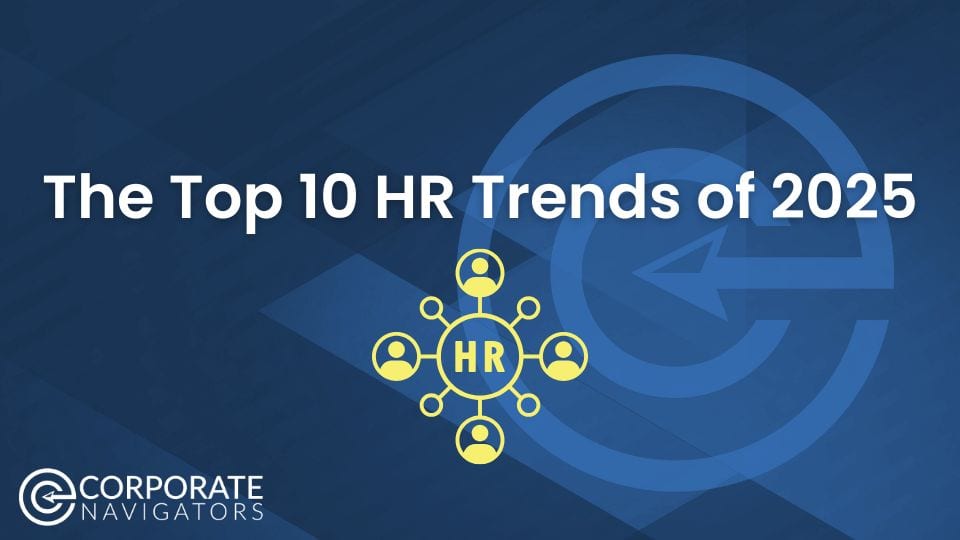
Table of Contents
Top 10 HR Trends
What HR Trends are shaping the workforce in 2025? At Corporate Navigators, we did some research to discover the common changes sweeping the professional world. As employer and candidate expectations continue to evolve, you can be sure that these trends will continue to change throughout the year.
1. Skills-Based Hiring Dominance
While college education still has value, more employers want to hire based on skills than a diploma. Therefore, prioritizing capabilities over credentials is accelerating, with 81% of employers now using skills-based hiring in their recruitment process.
In addition, fewer organizations are including degree requirements in job listings, with only 17.8% of job postings requiring degrees in 2024 vs. 20.4% in 2019. The overall reason for this shift is to address labor shortages and access overlooked talent pools, and skills-based hiring opens up new sources of qualified candidates.
2. AI-Driven HR Transformation
Generative AI is revolutionizing talent acquisition. You will see more HR chatbots and tools that handle routine inquiries to free HR teams for strategic work, while predictive analytics optimize workforce planning. Over 83% of HR leaders view upskilling as critical for AI readiness, so getting familiar with these workflows and tools will be on top of mind this year.
3. Upskilling for AI and Tech Integration
Employees are facing accelerating skill obsolescence as AI reshapes roles at a rapid pace. Many tasks traditionally done as human-only are becoming hybrid or fully automated. However, at this time, only 29% of organizations actively train workers collaborating with AI, despite nearly half of employees considering skill development a key factor when job-hopping. You can expect the demand for AI upskilling to increase as we navigate these critical changes in how we work.
4. Hybrid Work Evolution
The hybrid work model now covers 81% of workplaces, driving demand for tools that enhance remote collaboration and cybersecurity. Flexibility remains central to talent retention strategies as well, with Millennials leading the way in desire for remote or hybrid work. Being the largest generation currently in the workforce, the Millennial need for flex work will continue to influence the popularity of hybrid work now and in the near future.
5. DEI and Pay Transparency Advancements
Diversity, equity, and inclusion is important to nearly all members of Gen Z, which is poised to make up a third of the workforce by the year 2030. Therefore, you can expect to see organizations continue efforts to promote DEI with measures like diversity recruiting software, which minimizes bias through blind hiring and skill matching. Meanwhile, new laws will push compensation management tools for pay equity analysis. Overall, the global DEI market is projected to reach $15.4B by 2026.
6. An Augmented Employee Experience
Organizations understand how important holistic wellness is for the younger generations, but it’s also important to everyone across the board, with 81% of workers to be specific. As a result, employers will continue to integrate mental health, financial wellness, and physical health support. Coaching and mentoring platforms are also surging to foster growth.
7. Leadership Development Focus
Great leaders keep great employees around, so developing their skills is imperative to building a stable and lasting organization. In particular, leaders with empathy, adaptability, and authenticity are highly desired in today’s market. Therefore, manager training tops priority lists as organizations navigate AI adoption and cultural shifts.
8. Retention Through Personalization
It is far more cost-effective for organzations to retain talent then to start from zero and hire new people. Retention is also good for preserving legacy knowledge, which makes companies stronger. Retention strategies emphasize career pathing, flexible schedules, and soft skill development. Gen Z and Millennials demand mobile-friendly recruitment and inclusive cultures.
9. HR Automation and Internal Communications Integration
Automation tools are increasingly essential for streamlining HR processes such as onboarding, benefits management, and compliance, reducing administrative burdens and freeing HR teams to focus on strategic priorities.
Simultaneously, integration of internal communications software with HR platforms is becoming critical to unify employee engagement efforts, enabling consistent, personalized messaging and better workforce connection across diverse channels.
10. Blockchain for Secure and Transparent HR Processes
With the rise of AI tech, there needs to be more security in tow. Blockchain technology is emerging as a transformative tool in HR for enhancing security, transparency, and efficiency in processes like payroll, credential verification, and cross-border payments. Its decentralized, tamper-proof nature helps build trust, reduce errors, and save time, positioning blockchain as a key enabler for future-proofing HR operations.
What does this all mean?
In 2025, many HR trends reflect a convergence of technology and human-centric practices, with AI augmenting, but not replacing, strategic HR priorities around agility and employee empowerment. This aligns with Corporate Navigators and our mission to provide accurate research that’s verified with live sources and vetted by real humans. While AI is a great tool, nothing beats the discernment of experienced, human-led research.


